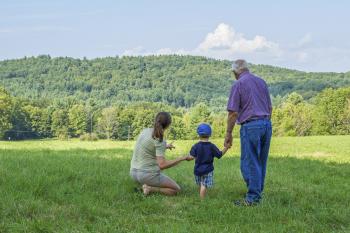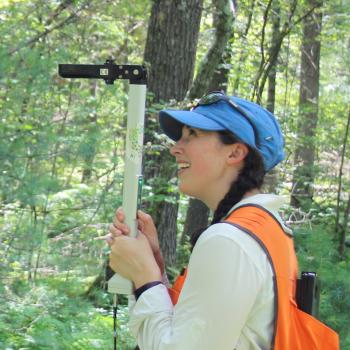In Our Spotlight
Trees Are In Trouble
We plant trees to celebrate births, honor lives lost, and commemorate graduations. We join together during the holidays to light a tree in the center of town. Couples walk down tree-lined paths, friends share picnics beneath a tree’s shade, and children grow up climbing trees in their backyards with neighborhood companions.Trees are also home to more than half of Earth’s land-based animals and plants. They help prevent soil erosion, flooding, desertification, and reduce the worst impacts of climate change.
But, today more than ever, trees are in trouble. In 2018, the US Forest Service reported that an estimated 36 million trees disappeared from U.S. urban/community areas between 2009 and 2014. This translates to around 175,000 acres of tree cover loss, the equivalent of losing 208 of New York City’s Central Park each year. Meanwhile, impervious ground covers like pavement are increasing by about 167,000 acres per year.
Throughout the Northeast, where woodlands sometimes seem to stretch to the horizon, trees are at risk. According to Mass Audubon, Massachusetts loses about 5,000 acres of forest, equal to about half the size of Provincetown, each year to a variety of culprits. Sugar maples, beeches, and a variety of pine species are all threatened by longer, hotter growing seasons, which are increasingly inhospitable for the vitality of these species. The Asian Longhorn beetle has wiped out over 30,000 urban trees in Worcester alone, and other invasive species such as the spotted lanternfly and emerald ash borer pose a growing threat. Even construction projects that are “environmentally friendly” like solar farms or wind turbines, threaten the health of surrounding trees.
But even as trees face significant and increasing threats, there is still plenty of hope, thanks to tree researchers and conservationists around the globe and right here in Massachusetts. Faculty working with the UMass Center for Agriculture, Food and Environment are hard at work looking into causes and potential solutions for tree loss in our rapidly changing world.
Rick Harper: Trees Are a Passion
At any given moment, Rick Harper – an Extension faculty member specializing in community forestry and urban landscaping – is engaged in research and extension programs with tree wardens and forestry professionals in nearly all Massachusetts towns and cities. As he puts it, “I have the best job in the world. No doubt. For sure. Trees are very exciting.” Here are just a few of Harper’s recent research endeavors in the world of trees:
Dutch Elm Disease:
The American Elm tree holds important cultural significance in New England; “almost every community has an elm street,” says Harper. Elms are easy to grow, tolerant to harsh conditions, and can live over 300 years. Massachusetts’ state tree is the American Elm. But since the late 1920s, Dutch elm disease has killed millions of trees, leaving urban areas with a considerable decrease in canopy cover. A review by Harper – along with Christopher Copeland (UMass PhD student in Urban Forestry), Nicholas Brazee (UMass Extension plant pathologist), and Forrest Bowlick (Geosciences) – examines and analyzes Dutch elm disease. Right now, the team is testing 200 trees on campus with seeds from the USDA Forest Service, looking to identify elm varieties that are most resistant to Dutch elm disease. From there, the most resistant varieties can be replanted in communities that have lost trees to the disease.
Oak Trees:
Oak trees are another research interest for Harper. “Oaks are great from a wildlife standpoint,” says Harper. The trees produce acorns, which then provide nutrients for all sorts of wildlife. Moreover, oak trees practice “marcescence,” meaning they hold onto their leaves that are normally shed by other species in the winter; wildlife can then forage those leaves for nests and other needs. Building on this research, Harper collaborated with Tierney Bocsi (UMass Master’s Candidate in Environmental Conservation), Paige Warren (Environmental Conservation), and Stephen DeStefano (Environmental Conservation) to publish a journal article describing the growth patterns and dynamics of oak trees in urban environments.
Wood Banks:
Not only is Harper working to prevent tree loss but he is also involved in conversations about woodbanks as a way to manage fallen trees and what to do when trees do come down. Similar to food banks, wood banks capture urban wood waste like tree trimmings, diseased trees, storm-damaged trees, etc., process it, and then provide it as free firewood. Since not all trees can be saved, providing people with heat can be a way to extend the usefulness of trees when they must come down.
Paul Catanzaro: The Family Forest Expert 
Paul Catanzaro is co-director of the Family Forest Research Center, a partnership between the USDA Forest Service and UMass Amherst. As an Extension faculty member specializing in privately-owned forests, Catanzaro’s work involves communicating with family forest owners, understanding their goals, and helping them make informed decisions about the future of their land, with the ultimate goal of forest conservation.
The fate of around 70% of Massachusetts forests are controlled by family forest owners. We are currently experiencing the largest intergenerational transfer of land ownership our nation has ever seen. During times of intergenerational transfer, says Catanzaro, the land is at its most vulnerable to development and conversion. This is because owners often parcel the land into smaller sections for each of their children to receive, or new owners decide to develop the land for financial benefit. To help forest owners make important decisions about their land’s future, Catanzaro integrates research, public education and outreach.
“The home run, so to speak, is that the land becomes permanently conserved, meaning that it can no longer be changed to residential or industrial development, that it would stay forest or its natural ecosystem in perpetuity,” says Catanzaro.
Two options help make this possible. The first is a conservation restriction, where a landowner continues to own their land, but certain rights are removed, such as the right to develop or mine on it. In return, the property tax the owner pays is often reduced significantly. Restrictions can be placed on the whole property or just portions of it, allowing for flexibility based on the owner's plans and preferences. The second option is for a landowner to sell or donate their land to a conservation organization, designating the land as permanently protected. Catanzaro has found the majority of landowners favor the conservation restriction option.
Of all the family forest owners Catanzaro and his team have engaged with, three-quarters of landowners decide to take action for the future of their land, and to preserve trees.
Meg Graham MacLean: The Quantitative Ecologist 
As a quantitative ecologist, Meg Graham MacLean focuses her research on forest ecology, environmental justice, and environmental education.
One of MacLean’s research endeavors answers questions about harvested wood products. Her research aims to learn about human wood utilization and the associated consequences, and more specifically, what happens to the carbon embodied in those products once we are done with them.
“When I think about forest carbon, which I do most days of the week,” says MacLean with a chuckle, “I think a lot about how to balance the need for us to really keep as much of our land in forests as possible with the needs of real live humans and energy needs.”
Her team runs future scenarios looking at the need for solar development vs. forest conservation. The goal is to find ways to minimize forest effects and balance the impacts of energy and development in such a way that no grouping is left behind.
“We need energy transition to renewable energy sources, we need housing for people, and we need forests for all of the wonderful benefits that they have for just being forests… It’s about maximizing the benefits for everyone,” says MacLean.
Ben Weil: Looking at Tree Loss from an Energy Standpoint
In 2008-2010, the invasive Asian Longhorned Beetle was threatening trees in Worcester. To combat the invasion, trees were removed, depriving the beetles of their food source. Because of this mass removal of trees in a concentrated area, particularly the Greendale and Burncoat neighborhoods in Worcester, Ben Weil, Extension Assistant Professor in Building and Construction Technology, was able to study neighborhoods and areas experiencing sudden tree loss. Given his interest in buildings and the associated energy use, Weil looked at how energy bills were impacted and what happened to the microclimate around them.
Of course, tree shade reduces heat gain on the ground. But a lesser-known fact is the cooling effects related to root and leaf systems. Trees take in water and through photosynthesis that water is evaporated back into the air. “Just like when you sweat – you’re cooler -- when [trees] evaporate water they actually lower the air temperature in the surrounding area,” says Weil.
A single tree might lower the temperature by just a fraction of a degree. But collectively, trees can create as much as a 10-degree difference in temperature based on tree density. “You can see how in a neighborhood with trees, people are more likely to go out and walk,” says Weil. “Just that half hour of walking a day adds up to years of life.”
In Worcester, Weil and the other researchers found that communities without trees used 40% more electricity for cooling than communities with trees. The financial impact of this increased cooling load was about $40 a month for the average home, translating to millions of extra dollars spent across large communities for cooling that trees happily provided by virtue of just being themselves.
Weil’s conclusions have contributed to the creation of a Department of Conservation and Recreation (DCR) “Greening the Gateway Communities” program that planted thousands of trees in lower-income cities, lowering cooling costs. The DCR and the Worcester Tree Initiative have also worked together to plant over 30,000 trees in Worcester, which has resulted in lower peak temperatures in the affected areas.
